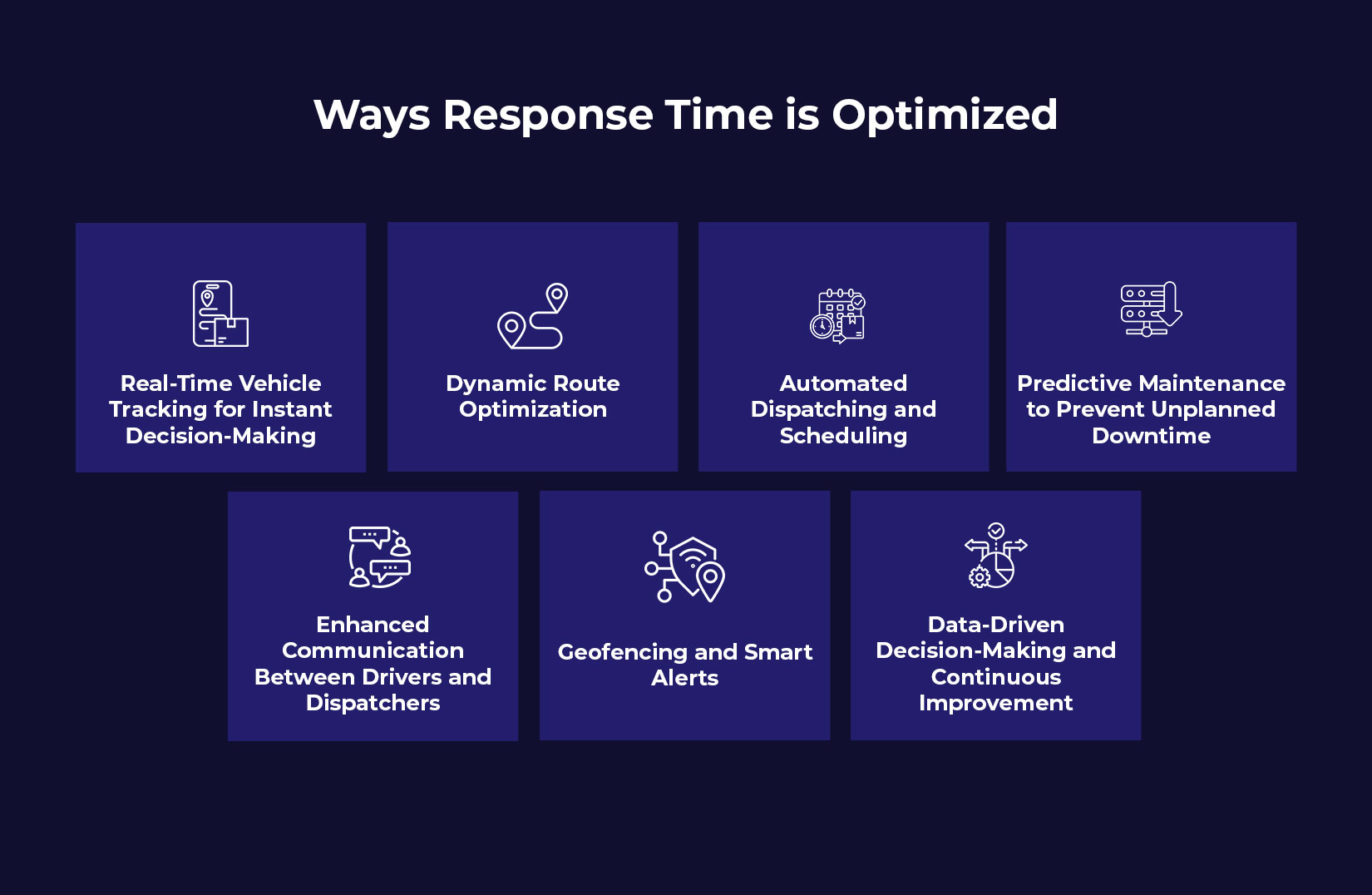
7 Ways Fleet Management Software Optimizes Response Times
In today’s high-speed logistics landscape, response time can make or break operational efficiency. Whether it’s dispatching emergency services, handling customer deliveries or coordinating supply chain logistics, every second counts. Fleet management software plays a pivotal role in optimizing these response times, offering businesses a smart data-driven approach to fleet coordination.
What is Fleet Management Software?
Fleet management software is an advanced tool that enables organizations to efficiently oversee and control their operations. It integrates multiple technologies – including real-time GPS tracking, vehicle diagnostics, automated scheduling and performance analytics. All of these makes it east to streamline day-to-day fleet activities.
By offering a centralized view of all vehicles, this type of fleet management system helps businesses improve operational efficiency, ensure driver safety, and reduce fuel consumption. From logistics providers and delivery services to utility companies and emergency responders, many industries rely on this technology to stay agile and responsive.
A robust solution not only simplifies coordination but also empowers managers to make smarter, faster decisions using real time insights. This ultimately helps in reducing delays, improving service quality and boosting overall performance.
Ways Response Time is Optimized

1. Real-Time Vehicle Tracking for Instant Decision-Making:
One of the core features of fleet management software is real-time GPS tracking. This allows fleet management to monitor the exact location of each vehicle, helping them make informed decisions instantly.
According to a study by MarketsandMarkets, real-time tracking solutions reduce vehicle idle time by up to 20%. In critical situations, such as last-minute rerouting or emergency service dispatch, knowing the exact location of a vehicle can reduce response time dramatically.
Fleet management technology leverages telematics and geo-fencing to alert managers when vehicles enter or exit predefined zones, ensuring faster responses to changing conditions on the road.
2. Dynamic Route Optimization:
Fleet management solutions use AI and machine learning to analyze traffic patterns, weather conditions, and road closures in real time. This ensures that drivers are always on the most efficient route.
Traditional static routes can lead to delays, especially during peak traffic hours. With advanced fleet management systems, routes are recalculated dynamically, minimizing delays and maximizing fleet responsiveness.
Statistically, dynamic route optimization can improve delivery times by 15% to 25%, according to research by Frost & Sullivan.
3. Automated Dispatching and Scheduling:
Manual scheduling can be time-consuming and prone to errors. Fleet management software automates dispatch and scheduling tasks using historical data and real-time inputs. This reduces downtime between jobs and ensures that the nearest available vehicle is assigned promptly.
This automation leads to faster turnaround and reduced human intervention, which in turn speeds up operations. The best fleet management systems allow for seamless integration with order management and customer service platforms, improving end-to-end visibility.
4. Predictive Maintenance to Prevent Unplanned Downtime:
Vehicle breakdowns can severely affect response times. Fleet management software helps mitigate this risk by monitoring vehicle health through telematics. It tracks key performance indicators such as engine diagnostics, tire pressure, and fuel efficiency.
By using predictive maintenance features, fleet managers can schedule repairs before a breakdown occurs. This not only improves vehicle availability but also prevents costly delays.
Fleet management technology can reduce unexpected breakdowns by up to 30%, according to research from Geotab. This ensures that more vehicles are road-ready at any given time.
5. Enhanced Communication Between Drivers and Dispatchers:
Clear communication is crucial in responding quickly to customer needs or on-ground challenges. Fleet management solutions often include integrated communication platforms such as in-app messaging or real-time alerts.
These tools ensure that drivers receive updates instantly. Whether it’s a new route, urgent delivery, or emergency pickup, without relying on time-consuming phone calls.
Improved communication reduces response times by facilitating rapid coordination between all stakeholders in the supply chain.
6. Geofencing and Smart Alerts:
Fleet management systems support geofencing. Geofencing allows businesses to set virtual boundaries around specific areas such as customer locations or service zones. When a vehicle enters or exits a zone, automatic alerts are triggered.
This feature is invaluable for industries like healthcare, security services, and logistics where time-sensitive responses are critical. For example, a medical courier service can be alerted the moment a vehicle nears a hospital, allowing the staff to prepare ahead of arrival.
Fleet management software enhances these capabilities by integrating smart alert systems that notify not only the fleet managers but also customers and third-party vendors.
7. Data-Driven Decision-Making and Continuous Improvement:
Fleet management technology collects vast amounts of operational data, from fuel usage to driver behaviour and delivery time metrics. This data can be analysed to identify bottlenecks and opportunities for improvement.
Over time, this leads to better decision-making, more efficient fleet deployment, and quicker response times. Businesses can set KPIs and track progress, enabling continuous performance optimisation.
A McKinsey report suggests that data analytics in fleet management can improve service levels by up to 20% while reducing operational costs.
Final Thoughts
Fast response times are a key competitive differentiator in logistics, delivery, emergency services, and field operations. Fleet management software empowers businesses with the tools and insights they need to achieve faster, more efficient, and more reliable responses.
By investing in a robust fleet management solution, companies can automate dispatching, optimize routing, and stay ahead of maintenance. This helps in ensuring their fleets are always ready to respond. Whether you’re running a delivery service or a municipal vehicle network, a modern fleet management system provides the visibility and control needed to stay agile in a fast-paced world.
In conclusion, adopting fleet management software is not just a technological upgrade, it’s a strategic move toward higher performance and customer satisfaction. So, click on the red button below and get the best fleet management software by LogiNext Solutions. Book a demo to know more.
39







@LogiNext